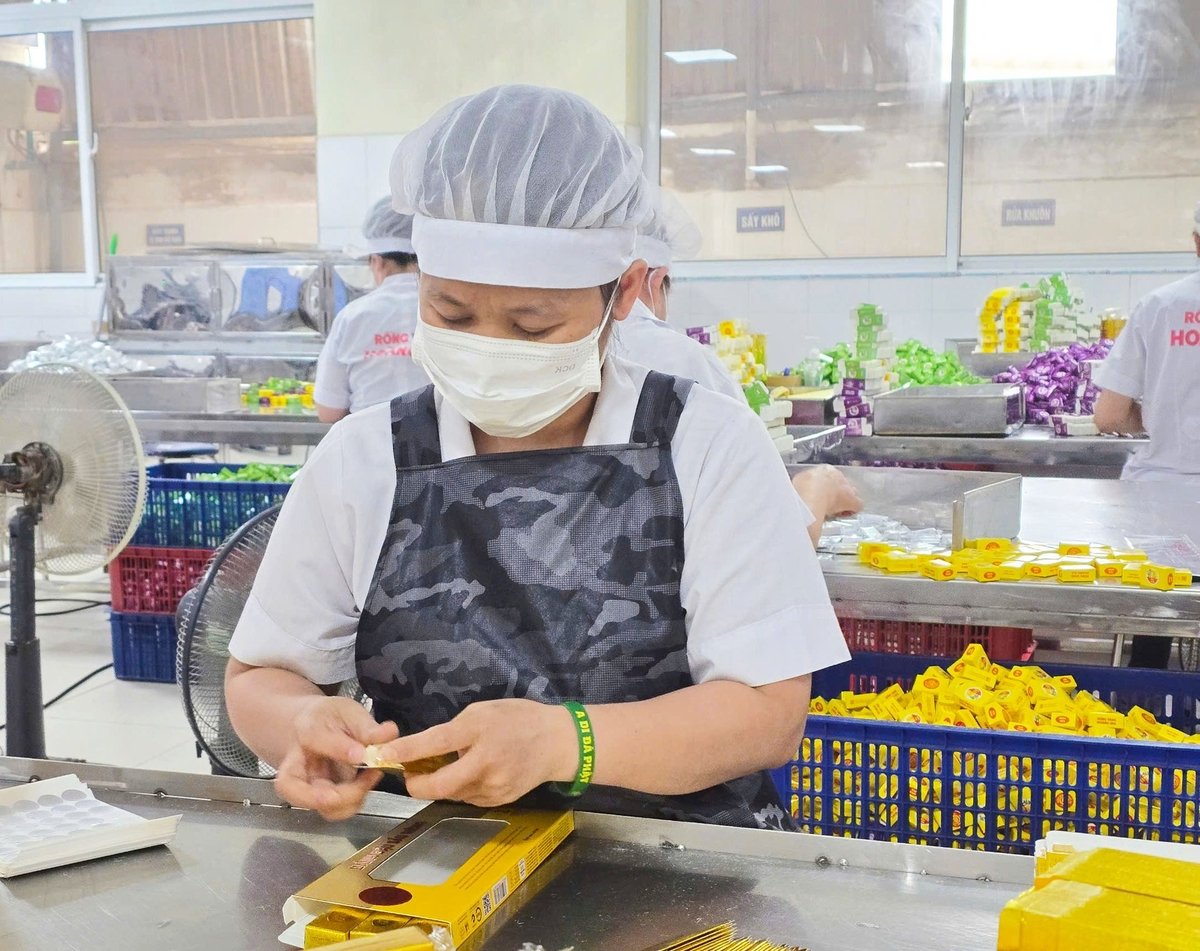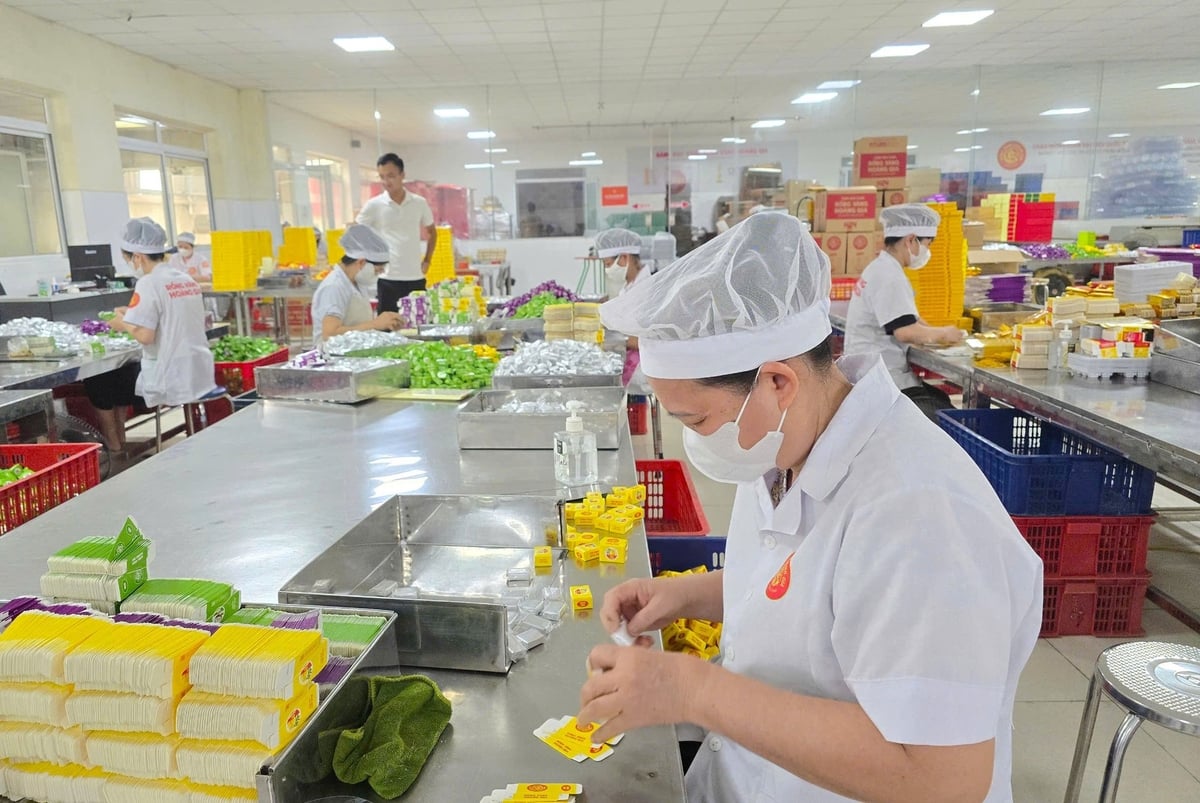December 7, 2025 | 14:51 GMT +7
December 7, 2025 | 14:51 GMT +7
Hotline: 0913.378.918
December 7, 2025 | 14:51 GMT +7
Hotline: 0913.378.918
Meeting Mr. Dao Quang Chuyen - Chairman of the Board of Directors of Hoang Gia Joint Stock Company, one can feel the burning passion in the eyes of a man who has devoted his life to mung bean cakes. His story and the brand’s journey are not just about sweet, fragrant cakes, but a challenging path to achieve the prestigious 5-star OCOP standard, a peak that few traditional products can reach.
“OCOP is not just a name; it’s a revolution. It forced us to look back to the roots, to the smallest details. To earn the 5-star title, everything must reach perfection. We had to ‘restandardize all input processing materials,’” Mr. Chuyen shared.

Mr. Dao Quang Chuyen proudly shares about the 5-star national OCOP mung bean cake. Photo: Dinh Muoi.
He explained that “superior quality” is the guiding principle. Golden-core mung beans, the soul of the cake, are carefully selected, ensuring each bean meets the standards of plumpness and unique fragrance. But innovation didn’t stop there. In a context where consumers care more about health and cholesterol, Hoang Gia boldly took a groundbreaking step: “Eliminating pork fat and replacing it with premium natural vegetable oil.”
This change not only makes the cakes light and less greasy but also significantly expands the customer base, from vegetarians and dieters to health-conscious consumers. It is clear evidence of listening to the market and applying science and technology to improve traditional products while preserving their core values.
The sweetness of the cakes is also meticulously refined. “We use 5-star refined sugar combined with a portion of glucose. This blend brings a mild, refreshing sweetness, distinct from the harsh sweetness of regular sugar. Each cake is a delicate taste experience,” Mr. Chuyen revealed.
The production process was also “refined” step by step to ensure food safety and consumer health. From raw material quality control to each processing and packaging stage, everything is strictly monitored and complies with rigorous hygiene standards. “This standardization is the key factor that helps us maintain consistent quality and build strong trust with customers,” Mr. Chuyen affirmed.
What truly sets Hoang Gia’s Rong Vang mung bean cake apart, winning over even the most demanding markets and tourists, is its “packaging design.” Mr. Chuyen proudly spoke about the “exclusive 5-star OCOP product line” featuring “Vietnamese bamboo boxes.”

Workers feel more passionate and dedicated as their long-standing product reaches new heights. Photo: Dinh Muoi.
“The bamboo box is not just packaging; it’s a miniature work of art. It’s eco-friendly, aligning with global sustainable consumption trends, and deeply ‘Vietnamese,’ matching our cuisine and culture. We want each cake to be not only a flavor gift but also a cultural gift that tells the story of Vietnam’s land and people,” he explained.
The rustic yet elegant beauty of the bamboo box has created a clear distinction in the confectionery market, especially appealing to premium customers and international travelers who seek uniqueness and authenticity in products. This is a smart marketing strategy that turns a traditional product into a cultural ambassador.
One strategic factor that opened a promising new chapter for Hoang Gia Joint Stock Company was the merger of Hai Duong Province into Hai Phong City - a “rare opportunity.”
According to Mr. Chuyen, the new Hai Phong is no longer just the old city; it has embraced Hai Duong, creating enormous potential. “From over 2 million people, we now have a market of more than 4 million consumers. More importantly, it’s the intersection of two economies with complementary strengths.”
Hai Duong has long been known for its rich agriculture, a land of specialties such as lychee, sticky rice, carrots, and sandworms. Meanwhile, Hai Phong is a major economic and industrial hub, strong in logistics, seaports, and import-export.

The production process is automated, meeting food safety and hygiene standards. Photo: Dinh Muoi.
“This combination creates a huge ‘development space’ for agricultural and aquatic products of the whole region. Hai Duong’s specialties, now under Hai Phong, will gain significant advantages in accessing seaport systems and Hai Phong’s modern industrial distribution channels. This shortens the supply chain, reduces logistics costs, and increases efficiency in reaching international markets,” Mr. Chuyen analyzed.
With this new advantage, the ambition to “strongly export to countries around the world” for mung bean cakes and other branded agricultural products is now closer than ever.
According to Mr. Dao Quang Chuyen, for the OCOP program and Vietnamese agricultural products to develop sustainably and advance, collaboration among stakeholders is essential. OCOP enterprises need to continue investing in R&D, innovate technology, and maintain competitiveness. It is crucial to adapt to and meet international standards for food safety and the environment. Furthermore, companies should actively form strong linkages, build sustainable value chains, and share experience and resources for collective strength.

Hoang Gia Joint Stock Company operates on a 6,000m² area with around 100 workers, generating an estimated annual revenue of 100 billion VND. Photo: Dinh Muoi.
On the State side, it’s important to continue reviewing and improving policies to support OCOP development. Favorable conditions should be created, and effective coordination mechanisms established among provinces, especially in the context of administrative mergers, to optimize local strengths and form large-scale logistics, processing, and agricultural export hubs. National and international trade promotion activities should also be strengthened to build a strong common brand, “OCOP Vietnam,” that is competitive in the global market.
“We focus on introducing our products to Japan, Canada, and the United States. The initial signals are very positive. This proves that Vietnamese products can fully meet strict standards and compete fairly globally. Hai Phong Port is the magic gateway for mung bean cakes carrying Vietnam’s essence to reach the vast seas,” Mr. Chuyen proudly added.
Translated by Hong Ngoc

(VAN) Despite numerous challenges, Vietnam's key seafood products are maintaining strong momentum, setting the stage for full-year exports to potentially reach USD 11 billion.

(VAN) The signing of a protocol between Viet Nam and China on the export of fresh jackfruit represents a significant milestone in agricultural trade cooperation between the two countries.

(VAN) On November 27, the Ninh Binh Department of Agriculture and Environment and the Institute for Green Growth Research organized a training course on greenhouse gas inventory for businesses.

(VAN) China’s cooking oil is suddenly flooding into India. It all comes down to a soybean surplus that Beijing doesn’t quite know what to do with.

(VAN) An Giang promotes supply-demand connections, standardizes quality and builds value chains, creating a foundation for sustainable bird’s nest development and aiming to expand exports.
/2025/11/24/5339-4-nongnghiep-075331.jpg)
(VAN) Recently, the conference on 'Sustainable Fisheries Linkage Chain - Tilapia for Export' took place in Tien Hai commune, Hung Yen province.
/2025/11/21/4309-2-153400_128.jpg)
(VAN) Green and low-emission rice is paving the way for Vietnamese rice to enter high-end markets, marking the beginning of a transformation journey toward greening and elevating the national rice brand.